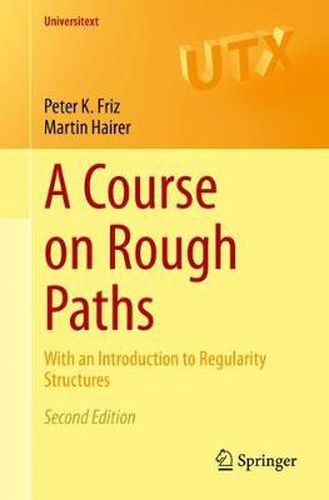Readings Newsletter
Become a Readings Member to make your shopping experience even easier.
Sign in or sign up for free!
You’re not far away from qualifying for FREE standard shipping within Australia
You’ve qualified for FREE standard shipping within Australia
The cart is loading…






This title is printed to order. This book may have been self-published. If so, we cannot guarantee the quality of the content. In the main most books will have gone through the editing process however some may not. We therefore suggest that you be aware of this before ordering this book. If in doubt check either the author or publisher’s details as we are unable to accept any returns unless they are faulty. Please contact us if you have any questions.
With many updates and additional exercises, the second edition of this book continues to provide readers with a gentle introduction to rough path analysis and regularity structures, theories that have yielded many new insights into the analysis of stochastic differential equations, and, most recently, stochastic partial differential equations.
Rough path analysis provides the means for constructing a pathwise solution theory for stochastic differential equations which, in many respects, behaves like the theory of deterministic differential equations and permits a clean break between analytical and probabilistic arguments. Together with the theory of regularity structures, it forms a robust toolbox, allowing the recovery of many classical results without having to rely on specific probabilistic properties such as adaptedness or the martingale property.
Essentially self-contained, this textbook puts the emphasis on ideas and short arguments, rather than aiming for the strongest possible statements. A typical reader will have been exposed to upper undergraduate analysis and probability courses, with little more than Ito-integration against Brownian motion required for most of the text.
From the reviews of the first edition:
Can easily be used as a support for a graduate course … Presents in an accessible way the unique point of view of two experts who themselves have largely contributed to the theory - Fabrice Baudouin in the Mathematical Reviews
It is easy to base a graduate course on rough paths on this … A researcher who carefully works her way through all of the exercises will have a very good impression of the current state of the art - Nicolas Perkowski in Zentralblatt MATH
$9.00 standard shipping within Australia
FREE standard shipping within Australia for orders over $100.00
Express & International shipping calculated at checkout
This title is printed to order. This book may have been self-published. If so, we cannot guarantee the quality of the content. In the main most books will have gone through the editing process however some may not. We therefore suggest that you be aware of this before ordering this book. If in doubt check either the author or publisher’s details as we are unable to accept any returns unless they are faulty. Please contact us if you have any questions.
With many updates and additional exercises, the second edition of this book continues to provide readers with a gentle introduction to rough path analysis and regularity structures, theories that have yielded many new insights into the analysis of stochastic differential equations, and, most recently, stochastic partial differential equations.
Rough path analysis provides the means for constructing a pathwise solution theory for stochastic differential equations which, in many respects, behaves like the theory of deterministic differential equations and permits a clean break between analytical and probabilistic arguments. Together with the theory of regularity structures, it forms a robust toolbox, allowing the recovery of many classical results without having to rely on specific probabilistic properties such as adaptedness or the martingale property.
Essentially self-contained, this textbook puts the emphasis on ideas and short arguments, rather than aiming for the strongest possible statements. A typical reader will have been exposed to upper undergraduate analysis and probability courses, with little more than Ito-integration against Brownian motion required for most of the text.
From the reviews of the first edition:
Can easily be used as a support for a graduate course … Presents in an accessible way the unique point of view of two experts who themselves have largely contributed to the theory - Fabrice Baudouin in the Mathematical Reviews
It is easy to base a graduate course on rough paths on this … A researcher who carefully works her way through all of the exercises will have a very good impression of the current state of the art - Nicolas Perkowski in Zentralblatt MATH